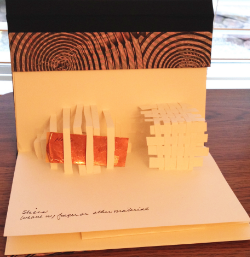Philosophy & Fiction
Camus's review of Sartre's first novel, Nausea, initially appeared in Alger republicain, the Algerian newspaper. In it, Camus made this claim about the relationship between philosophy and fiction:
A novel is never anything but a philosophy put into images. And in a good novel, the whole of philosophy has passed into images. But the philosophy need only spill over into the characters and action for . . . the plot to lose its authenticity and the novel its life. Nevertheless, a work that is to last cannot dispense with profound ideas. And this secret fusion between experiences and thought, between life and reflection on the meaning of life is what makes a great novelist.
Camus went on to say that Sartre, an obviously gifted writer, had failed to maintain that critical balance between philosophy and fiction and had allowed his theories to "do damage to the life" of the story. More should be expected from such a great and promising talent, Camus thought. ("On Jean-Paul Sartre's La Nausee," in Lyrical & Critical Essays, Albert Camus, Knopf, 1968, Philip Thody, Ed., Ellen Conroy Kennedy, Tr., p. 1968.)
Camus's real objection wasn't so much literary as it was a fundamental disagreement with Sartre's view of the world, which disagreement is the actual subject of his criticism:
For it is the failing of certain literature to believe that life is tragic because it is wretched. . . Life can be magnificent and overwhelming—that is its whole tragedy. Without beauty, love, or danger it would be almost easy to live. And M. Sartre's hero does not perhaps give us the real meaning of his anguish when he insists on those aspects of man he finds repugnant, instead of basing his reasons for despair on certain of man's signs of greatness. (p. 201)
Camus seems to be saying that despair is legitimate only when it is measured against the opposing possibilities of "beauty, love or danger."
Some might argue that Camus's characters also live in darknesses inflicted from within and without that are as great as Sartre's and with a similar lack of hope. It is a difficult argument to rebut. Still, it seems to me that Camus's characters persevere toward the good if not the better, and we are left with the sense that however deep their wounds and ours, healing begins with knowing and accepting what life brings and carrying on. In his analysis of the myth of Sisyphus, Camus admits that the life Sisyphus lives is absurd, but argues that such a life is not meaningless:
I leave Sisyphus at the foot of the mountain! One always find one's burden again. But Sisyphus teaches the higher fidelity that negates the gods and raises rocks. He too concludes that all is well. This universe henceforth without a master seems to him neither sterile nor futile. Each atom of that stone, each mineral flake of that night-filled mountain, in itself forms a world.The struggle itself toward the heights is enough to fill a man's heart. One must imagine Sisyphus happy. (The Myth of Sisyphus and Other Essays, Vintage, 1955, p. 123)
The point Camus makes may seem quaint in view today's literary output, much of which, if it aspires at all, aspires to concerns, characters, and plots that lean more in Sartre's direction than toward Camus's famous statement: In the depths of winter, I finally learned that within me there lay an invincible summer. . . . Yes, there is beauty and there are the humiliated. Whatever difficulties the enterprise may present, I would like never to be unfaithful either to the one or the other. ("Return to Tipasa", Lyrical & Critical Essays, p. 169). This profound search for balance, especially in our own deeply unbalanced times, appeals to our better selves and comforts us with the possibility that it is our very awareness of beauty, love, and danger that will ultimately overcome the causes of our despair.














